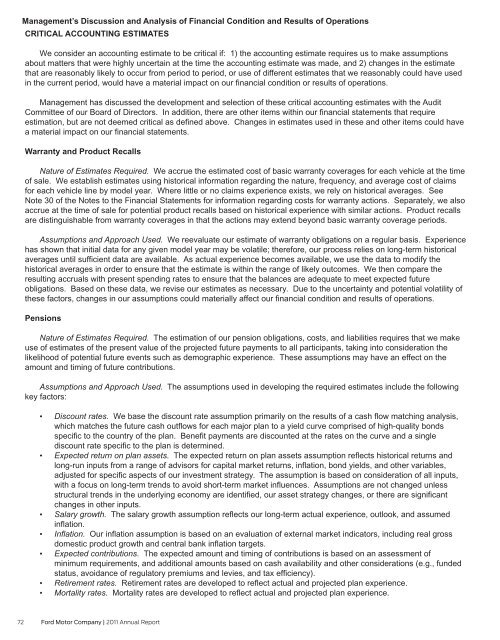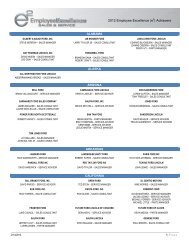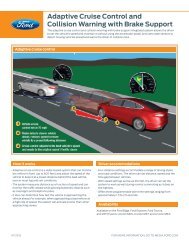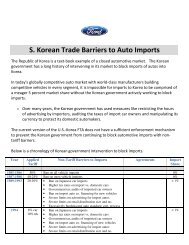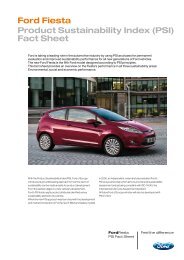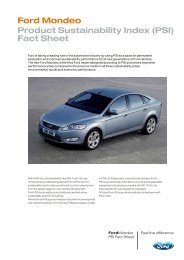Annual Report 2011 - Ford Motor Company
Annual Report 2011 - Ford Motor Company
Annual Report 2011 - Ford Motor Company
You also want an ePaper? Increase the reach of your titles
YUMPU automatically turns print PDFs into web optimized ePapers that Google loves.
Management’s Discussion and Analysis of Financial Condition and Results of Operations<br />
CRITICAL ACCOUNTING ESTIMATES<br />
We consider an accounting estimate to be critical if: 1) the accounting estimate requires us to make assumptions<br />
about matters that were highly uncertain at the time the accounting estimate was made, and 2) changes in the estimate<br />
that are reasonably likely to occur from period to period, or use of different estimates that we reasonably could have used<br />
in the current period, would have a material impact on our financial condition or results of operations.<br />
Management has discussed the development and selection of these critical accounting estimates with the Audit<br />
Committee of our Board of Directors. In addition, there are other items within our financial statements that require<br />
estimation, but are not deemed critical as defined above. Changes in estimates used in these and other items could have<br />
a material impact on our financial statements.<br />
Warranty and Product Recalls<br />
Nature of Estimates Required. We accrue the estimated cost of basic warranty coverages for each vehicle at the time<br />
of sale. We establish estimates using historical information regarding the nature, frequency, and average cost of claims<br />
for each vehicle line by model year. Where little or no claims experience exists, we rely on historical averages. See<br />
Note 30 of the Notes to the Financial Statements for information regarding costs for warranty actions. Separately, we also<br />
accrue at the time of sale for potential product recalls based on historical experience with similar actions. Product recalls<br />
are distinguishable from warranty coverages in that the actions may extend beyond basic warranty coverage periods.<br />
Assumptions and Approach Used. We reevaluate our estimate of warranty obligations on a regular basis. Experience<br />
has shown that initial data for any given model year may be volatile; therefore, our process relies on long-term historical<br />
averages until sufficient data are available. As actual experience becomes available, we use the data to modify the<br />
historical averages in order to ensure that the estimate is within the range of likely outcomes. We then compare the<br />
resulting accruals with present spending rates to ensure that the balances are adequate to meet expected future<br />
obligations. Based on these data, we revise our estimates as necessary. Due to the uncertainty and potential volatility of<br />
these factors, changes in our assumptions could materially affect our financial condition and results of operations.<br />
Pensions<br />
Nature of Estimates Required. The estimation of our pension obligations, costs, and liabilities requires that we make<br />
use of estimates of the present value of the projected future payments to all participants, taking into consideration the<br />
likelihood of potential future events such as demographic experience. These assumptions may have an effect on the<br />
amount and timing of future contributions.<br />
Assumptions and Approach Used. The assumptions used in developing the required estimates include the following<br />
key factors:<br />
• Discount rates. We base the discount rate assumption primarily on the results of a cash flow matching analysis,<br />
which matches the future cash outflows for each major plan to a yield curve comprised of high-quality bonds<br />
specific to the country of the plan. Benefit payments are discounted at the rates on the curve and a single<br />
discount rate specific to the plan is determined.<br />
• Expected return on plan assets. The expected return on plan assets assumption reflects historical returns and<br />
long-run inputs from a range of advisors for capital market returns, inflation, bond yields, and other variables,<br />
adjusted for specific aspects of our investment strategy. The assumption is based on consideration of all inputs,<br />
with a focus on long-term trends to avoid short-term market influences. Assumptions are not changed unless<br />
structural trends in the underlying economy are identified, our asset strategy changes, or there are significant<br />
changes in other inputs.<br />
• Salary growth. The salary growth assumption reflects our long-term actual experience, outlook, and assumed<br />
inflation.<br />
• Inflation. Our inflation assumption is based on an evaluation of external market indicators, including real gross<br />
domestic product growth and central bank inflation targets.<br />
• Expected contributions. The expected amount and timing of contributions is based on an assessment of<br />
minimum requirements, and additional amounts based on cash availability and other considerations (e.g., funded<br />
status, avoidance of regulatory premiums and levies, and tax efficiency).<br />
• Retirement rates. Retirement rates are developed to reflect actual and projected plan experience.<br />
• Mortality rates. Mortality rates are developed to reflect actual and projected plan experience.<br />
72 <strong>Ford</strong> <strong>Motor</strong> <strong>Company</strong> | <strong>2011</strong> <strong>Annual</strong> <strong>Report</strong>


